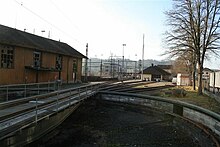Slewing gear
A slewing gear , also known as a slewing ring , is a connecting element in technology and mechanical engineering for the transmission of rotary movements with a simultaneous blocking of the remaining 5 degrees of freedom (3 translations, 2 rotations). This storage usually has to transmit very large axial forces and absorb tilting moments. Classic applications are the slewing gear on cranes or excavators, as well as the rotatable mounting of the front axle on the drawbar of a truck trailer .
Technical development
Roller turntables
Until the beginning of the 20th century, the development of ball bearings was limited to applications with lower forces for reasons of strength. In conveyor technology, especially with cranes and excavators, the problem arose that a large part of the machine had to be rotatably mounted on the chassis, but at the same time had to be tilt-proof. A circular rail track was used for this, on which wheels mounted in the superstructure rolled. To prevent the superstructure from tilting, the engineers placed a steel pin, the king pin, in the middle of the track . This type of storage was also used in mill construction.
Cylindrical roller lathes
Due to the dimensions and the unevenly distributed load on the individual wheels, the cylinder roller slewing gear was developed in the first half of the 20th century. The wheels were replaced by smaller cylindrical rollers. These are not stored in the superstructure, but on a separate roller carrier on the kingpin. Thus, like a cylindrical roller bearing, they can roll between a track on the lower and upper structure. However, the kingpin was still necessary to absorb the tilting moments, and claws were also used.
These are rolling bearings that consist of two rings that are rotatably mounted against each other with the help of balls or rolling elements (rollers) .
Slewing rings
The next stage of development are the ball slewing rings that are common today. Balls run on obliquely arranged annular tracks like in an angular contact ball bearing and can thus absorb axial forces and tilting moments. The entire bearing is protected against grease leakage and dirt with seals. For special applications there is a large number of further developed designs, e.g. B. with several ball tracks.
Applications
- Conveyor technology:
- Excavator
- Large open-cast mining equipment ( bucket wheel excavators etc.)
- Wind turbines:
- Windmills
- modern wind turbines
- Traffic engineering:
- Turntables (railway)
- Drawbar mounting for larger commercial vehicle trailers
- Articulated buses
- Rotating ring mounts
- Machine tools
See also
- Gun bank (a form of gun support)
Web links
- Efficient energy recuperation in diesel-electric mobile harbor cranes (accessed on June 4, 2020)
- Method and device for positioning a crane load hanging on a cable suspension of a crane system in the direction of rotation around its vertical axis (accessed on June 4, 2020)
- Evaluation of the energy efficiency of construction machines with the help of a practical load cycle development for an in-situ test (accessed on June 4, 2020)
- Testing of cranes (accessed June 4, 2020)
- Install a new slewing ring (accessed June 4, 2020)



